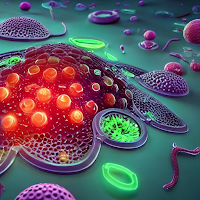Chromosomal stability is central to good health, but the push and shove war of genesis, division, transcription, replication and restraint can promote disorder. Disruption can also be retained resulting in ageing, reduced organ function or diseases that often follow. Recently a man escaped his genetic predisposition, to becoming a victim of Alzheimer's disease, illustrating how far we are from understanding even the most well studied conditions.
Active or passive, mobile Transposable Elements (TE) represent around 40-50% of the human genome and around 30% are found in the non-coding introns of genes. The first intron is conserved as a site of downstream methylation with an inverse relationship to transcription and gene expression. Our understanding of non-coding RNA (ncRNA) suggests one of its primary functions is the restraint of mobile TE's. Several species of ncRNA are associated with this restraint and genomic stability, most contain p53 binding sites that are also known to be involved in tumor suppression.
Of the short ncRNA species, LINE-1 (L1), siRNAs are typically 21-23 nucleotides long and play a role in silencing L1 transcripts, thus preventing retro-transposition. p53 binds the L1 promoter to restrict autonomous copies of these mobile elements in human cells. Alu elements are the most abundant transposable elements (capable of shifting their positions) containing over one million copies dispersed throughout the human genome. As little as 0.7% sequence divergence resulted in a significant reduction in recombination after double stranded breaks. piRNAs, usually 26-31 nucleotides, derived from Alu repeats restrain transposable elements. Endogenous Retroviruses (ERVs) can give rise to microRNAs (miRNAs) of 22 nucleotides, that can regulate the expression of ERV sequences and other cellular genes.
TE's serve as templates for the generation of p53- binding-sites on a genome-wide scale . The formation of the p53 binding motifs was facilitated via methylation and deamination that distributes p53-binding sites and recruits new target genes to its regulatory network in a species-specific manner. This p53 mechanism conducts genomic restraint, where instability and loss or mutation of p53 are commonly associated with hallmark's of cancer.
Through a novel piRNA of the KIR3DL1 gene, antisense transcripts mediate Killer Ig-like receptor (KIR) transcriptional silencing in Natural Killer (NK) cell lineage that may be broadly used in orchestrating immune development. Silencing individual KIR genes is strongly correlated with the presence of CpG dinucleotide methylation within the promoter.
The emergence of recombination-activating genes (RAGs) in jawed vertebrates endowed adaptive immune cells with the ability to assemble a diverse set of antigen receptor genes. Innate NK cells are unable to express RAGs or RAG endonuclease activity during ontogeny. However, RAG expression in uncommitted hematopoietic progenitors and NK cell precursors mark functionally distinct subsets of NK cells in the periphery, a surprising and novel role for RAG in the functional specialization of the NK cell lineage.
The p53 C-terminal including amino acids 360-393 of the full-length protein locate to the mitochondrial permeability transition pore and facilitate apoptosis. However fragments of p53 at amino acid 1-186 and 22-186 drive the most mitochondrial depolarization. Crystal structures demonstrate amino acid 239 binds 106 and 241 binds 105 for one p53 unit and 243 binds 103-264-265 for a second unit, which are both are required to bind BCL-xl for apoptosis.
p53 regulates the expression of major histocompatibility complex (MHC) class I on cell surfaces. p53 peptides presented on HLA/MHC-I could attract immune surveillance as in the target-specific antitumor effects of p53 amino acids at positions 264-272, epitope 264scTCR with IL-2 on p53+/HLA-A2.1+ tumors that are primarily mediated by NK cells.
Initially, NK cells might be activated due to the combined effect of reduced inhibition (due to decreased KIR3DL1) and increased activation signals from p53 epitopes. This NK cell activation could lead to the release of cytokines that not only enhance further NK activity but also attract and activate T cells.
To summarize, p53 can influence both the presentation of its antigens through MHC-I and the regulation of NK cell inhibitory receptors like KIR3DL1 via piRNA. This could lead to a more effective immune response against cells with compromised p53 function, although the exact dynamics would depend on the specific context of cancer development, immune cell status, and individual genetic variations.







